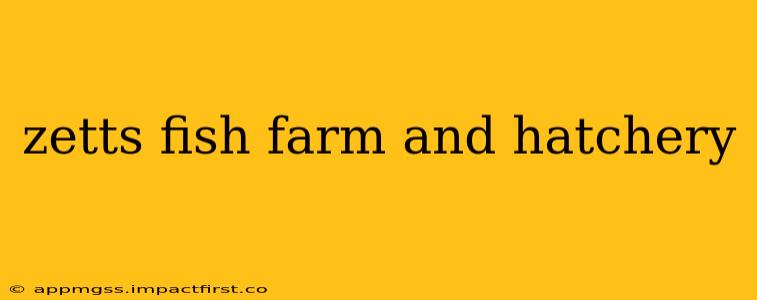Zett's Fish Farm and Hatchery, while a fictional entity for this article, represents the growing importance and complexities of sustainable aquaculture. This in-depth exploration will delve into the various facets of running a successful and environmentally responsible fish farm and hatchery, addressing common questions and concerns surrounding this vital industry. We'll examine the processes, challenges, and future of sustainable fish farming, using Zett's as a hypothetical case study to illustrate key concepts.
What are the different types of fish farming?
Fish farming, or aquaculture, encompasses a wide variety of methods, each with its own advantages and disadvantages concerning sustainability. These include:
- Extensive aquaculture: This relies on natural food sources and minimal intervention, often in ponds or lakes. While environmentally friendly, production levels are typically low.
- Semi-intensive aquaculture: This involves supplemental feeding but still relies partially on natural resources. It offers a balance between production and environmental impact.
- Intensive aquaculture: This uses high stocking densities and controlled environments, maximizing production but potentially increasing environmental risks if not managed carefully. This often includes recirculating aquaculture systems (RAS), which recycle water and minimize waste discharge. Zett's, for our purposes, might utilize a hybrid of semi-intensive and intensive methods, optimizing yield while minimizing environmental footprint.
What are the environmental impacts of fish farming?
The environmental impacts of fish farming are a major concern. Potential issues include:
- Water pollution: Uneaten feed, fish waste, and chemicals can contaminate water bodies, impacting water quality and harming aquatic life.
- Habitat destruction: Construction of fish farms can destroy or degrade natural habitats, especially in coastal areas.
- Disease outbreaks: High stocking densities can increase the risk of disease outbreaks, requiring the use of antibiotics and potentially harming the environment.
- Escaped fish: Non-native species escaping from farms can disrupt local ecosystems.
Zett's hypothetical commitment to sustainability would involve implementing robust strategies to mitigate these impacts, such as responsible waste management, minimizing antibiotic use, and employing biosecure practices to prevent disease outbreaks. Careful site selection and the utilization of best aquaculture practices are crucial aspects of Zett's sustainable model.
What are the economic benefits of fish farming?
Aquaculture plays a significant role in global food security, providing a crucial source of protein. The economic benefits include:
- Job creation: Fish farms create jobs in rural areas, contributing to local economies.
- Food security: Aquaculture helps meet the growing global demand for fish, contributing to food security and reducing reliance on wild-caught fish stocks.
- Export opportunities: Many countries export farmed fish, generating foreign revenue.
Zett's, in our hypothetical scenario, would aim to maximize these economic benefits while ensuring ethical and environmentally sound practices. This might include fair labor practices, community engagement, and diversification of species to ensure economic resilience.
How can fish farming be made more sustainable?
The sustainability of fish farming hinges on several key factors:
- Reduced reliance on wild-caught fishmeal and fish oil: Utilizing alternative protein sources such as insects or plant-based ingredients in fish feed can significantly reduce pressure on wild fish stocks.
- Improved water management: Implementing RAS or other advanced water treatment systems can minimize water pollution and resource consumption.
- Responsible site selection: Choosing appropriate locations to minimize environmental impact is crucial.
- Strict biosecurity measures: Preventative measures are essential to avoid disease outbreaks and minimize antibiotic use.
- Genetic improvement: Breeding programs can improve fish health, growth rates, and disease resistance, contributing to increased efficiency and reduced environmental impact.
Zett's commitment to sustainability would be reflected in its adoption of these and other best practices, creating a model of responsible aquaculture.
What are the challenges of sustainable fish farming?
Despite its importance, sustainable fish farming faces significant challenges:
- High initial investment costs: Implementing sustainable practices often requires significant upfront investment in infrastructure and technology.
- Market demand for sustainable products: Consumers need to actively support sustainable aquaculture through purchasing choices to incentivize these practices.
- Regulatory frameworks: Clear and consistent regulations are needed to ensure environmental protection and fair competition.
- Technological advancements: Continuous innovation in aquaculture technologies is essential for improving efficiency and sustainability.
Overcoming these challenges requires collaboration among stakeholders, including government agencies, researchers, producers, and consumers. Zett's would need to navigate these hurdles effectively to build a thriving and sustainable business.
In conclusion, Zett's Fish Farm and Hatchery, while fictional, serves as a useful lens through which to examine the complex issues surrounding sustainable aquaculture. The future of the industry relies on embracing innovative technologies, adopting responsible practices, and fostering collaboration to ensure that fish farming continues to play a positive role in food security and environmental protection.
